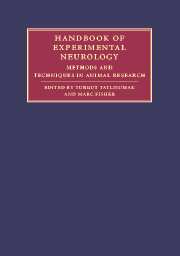Book contents
- Frontmatter
- Contents
- List of contributors
- Part I Principles and general methods
- 1 Introduction: Animal modeling – a precious tool for developing remedies to neurological diseases
- 2 Ethical issues, welfare laws, and regulations
- 3 Housing, feeding, and maintenance of rodents
- 4 Identification of individual animals
- 5 Analgesia, anesthesia, and postoperative care in laboratory animals
- 6 Euthanasia in small animals
- 7 Various surgical procedures in rodents
- 8 Genetically engineered animals
- 9 Imaging in experimental neurology
- 10 Safety in animal facilities
- 11 Behavioral testing in small-animal models: ischemic stroke
- 12 Methods for analyzing brain tissue
- 13 Targeting molecular constructs of cellular function and injury through in vitro and in vivo experimental models
- 14 Neuroimmunology and immune-related neuropathologies
- 15 Animal models of sex differences in non-reproductive brain functions
- 16 The ependymal route for central nervous system gene therapy
- 17 Neural transplantation
- Part II Experimental models of major neurological diseases
- Index
- References
6 - Euthanasia in small animals
Published online by Cambridge University Press: 04 November 2009
- Frontmatter
- Contents
- List of contributors
- Part I Principles and general methods
- 1 Introduction: Animal modeling – a precious tool for developing remedies to neurological diseases
- 2 Ethical issues, welfare laws, and regulations
- 3 Housing, feeding, and maintenance of rodents
- 4 Identification of individual animals
- 5 Analgesia, anesthesia, and postoperative care in laboratory animals
- 6 Euthanasia in small animals
- 7 Various surgical procedures in rodents
- 8 Genetically engineered animals
- 9 Imaging in experimental neurology
- 10 Safety in animal facilities
- 11 Behavioral testing in small-animal models: ischemic stroke
- 12 Methods for analyzing brain tissue
- 13 Targeting molecular constructs of cellular function and injury through in vitro and in vivo experimental models
- 14 Neuroimmunology and immune-related neuropathologies
- 15 Animal models of sex differences in non-reproductive brain functions
- 16 The ependymal route for central nervous system gene therapy
- 17 Neural transplantation
- Part II Experimental models of major neurological diseases
- Index
- References
Summary
Only rarely does an animal experiment end in the natural death of the animal. In most cases, the animals must be killed following the completion of the experiment and certain tissue samples or organs must be collected. Even if the animal is fairly healthy after the experiment and even if it is not necessary to collect tissues, releasing laboratory animals into nature is strictly forbidden. Euthanasia is an important part of animal experimentation and every researcher who uses animals should be aware of the techniques and principles involved. There are a number of universally approved methods for euthanasia, but they may differ in different countries and different institutions even within the same country. This chapter will discuss the main methods of euthanasia. Every researcher must first consult the relevant authorities in their institution that provide permission for animal experiments, including the method of sacrifice. Only trained and competent personnel may carry out euthanasia within dedicated/suitable and approved facilities and only using methods approved by relevant authorities. Most animal facilities have veterinary physicians who are available for consultation and training purposes. The method for euthanasia should always be stated in detail in study plans and applications to the institutional body for animal care and use for scientific purposes. The method of euthanasia varies according to the animal species, number, nature of the experiment, and the intention of use of various organs for further research following death. Other animals and unnecessary personnel must not witness or hear the euthanasia procedures.
Information
- Type
- Chapter
- Information
- Handbook of Experimental NeurologyMethods and Techniques in Animal Research, pp. 67 - 74Publisher: Cambridge University PressPrint publication year: 2006
